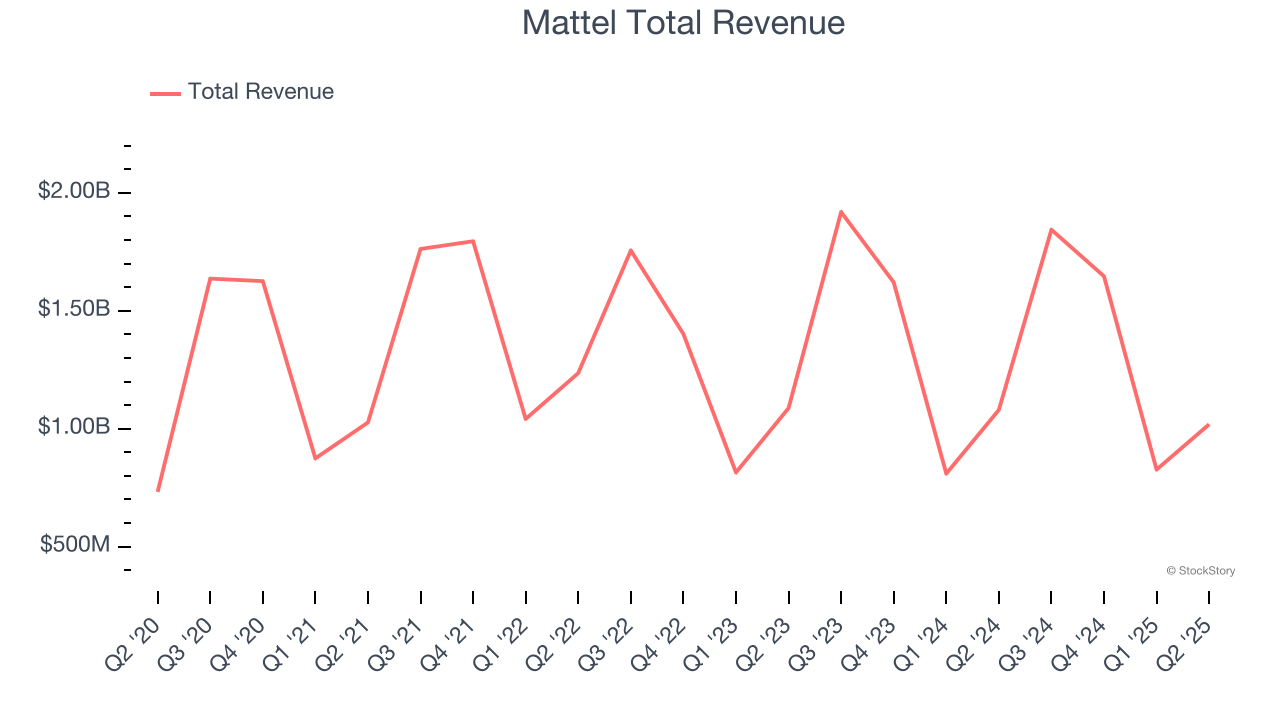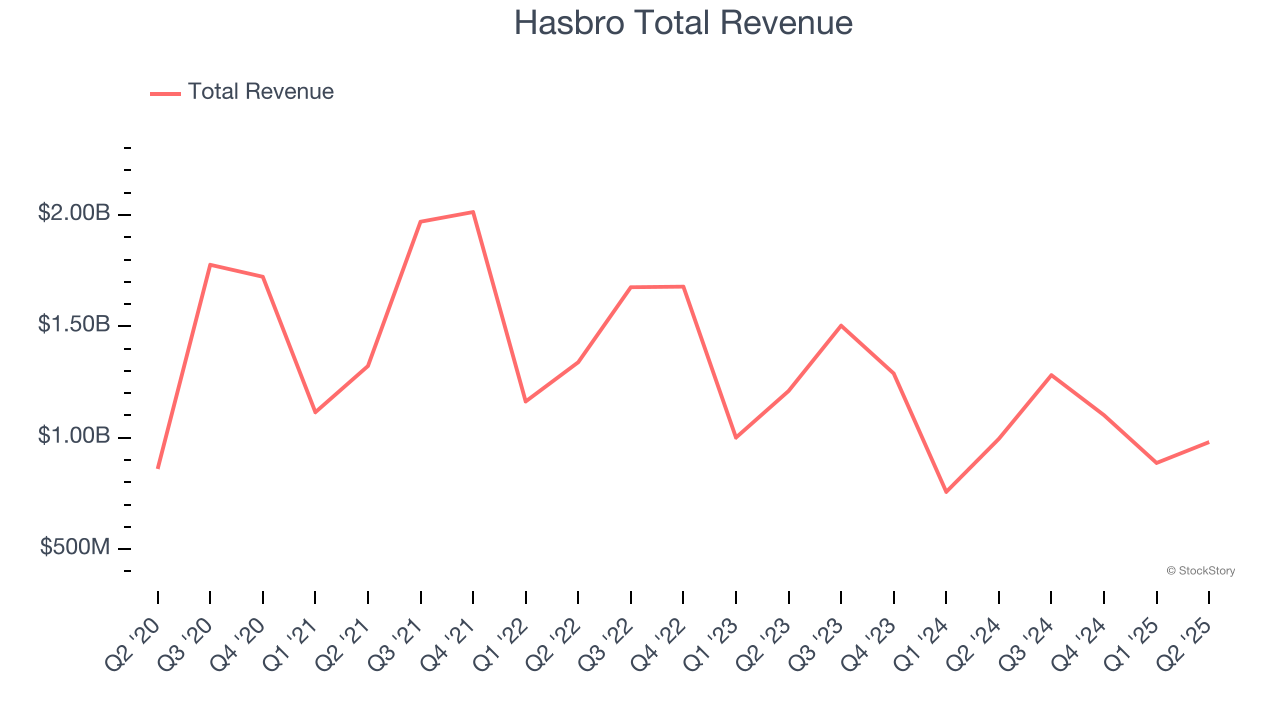
Earnings results often indicate what direction a company will take in the months ahead. With Q2 behind us, let’s have a look at Mattel (NASDAQ: MAT) and its peers.
The toys and electronics industry presents both opportunities and challenges for investors. Established companies often enjoy strong brand recognition and customer loyalty while smaller players can carve out a niche if they develop a viral, hit new product. The downside, however, is that success can be short-lived because the industry is very competitive: the barriers to entry for developing a new toy are low, which can lead to pricing pressures and reduced profit margins, and the rapid pace of technological advancements necessitates continuous product updates, increasing research and development costs, and shortening product life cycles for electronics companies. Furthermore, these players must navigate various regulatory requirements, especially regarding product safety, which can pose operational challenges and potential legal risks.
The 4 toys and electronics stocks we track reported a mixed Q2. As a group, revenues beat analysts’ consensus estimates by 4% while next quarter’s revenue guidance was 0.8% below.
Amidst this news, share prices of the companies have had a rough stretch. On average, they are down 5% since the latest earnings results.
Mattel (NASDAQ: MAT)
Known for the creation of iconic toys such as Barbie and Hotwheels, Mattel (NASDAQ: MAT) is a global children's entertainment company specializing in the design and production of consumer products.
Mattel reported revenues of $1.02 billion, down 5.7% year on year. This print fell short of analysts’ expectations by 3.2%. Overall, it was a mixed quarter for the company with a beat of analysts’ EPS estimates.
Ynon Kreiz, Chairman and CEO of Mattel, said: “Our second quarter performance reflects operational excellence in the current macroeconomic environment as we continue to execute our strategy to grow Mattel’s IP-driven toy business and expand our entertainment offering. We achieved meaningful gross margin expansion, grew internationally, and further progressed our entertainment slate. We are embracing technology and collaborating with world-class partners to bring our iconic brands to life in new ways to position Mattel for long-term success.”

Mattel delivered the weakest performance against analyst estimates of the whole group. Unsurprisingly, the stock is down 13.4% since reporting and currently trades at $17.49.
Is now the time to buy Mattel? Access our full analysis of the earnings results here, it’s free.
Best Q2: Hasbro (NASDAQ: HAS)
Credited with the creation of toys such as Mr. Potato Head and the Rubik’s Cube, Hasbro (NASDAQ: HAS) is a global entertainment company offering a diverse range of toys, games, and multimedia experiences for children and families.
Hasbro reported revenues of $980.8 million, down 1.5% year on year, outperforming analysts’ expectations by 11.2%. The business had a stunning quarter with a beat of analysts’ EPS and EBITDA estimates.

Hasbro delivered the biggest analyst estimates beat and fastest revenue growth among its peers. Although it had a fine quarter compared its peers, the market seems unhappy with the results as the stock is down 2.9% since reporting. It currently trades at $75.36.
Is now the time to buy Hasbro? Access our full analysis of the earnings results here, it’s free.
Weakest Q2: Funko (NASDAQ: FNKO)
Boasting partnerships with media franchises like Marvel and One Piece, Funko (NASDAQ: FNKO) is a company specializing in creating and distributing licensed pop culture collectibles.
Funko reported revenues of $193.5 million, down 21.9% year on year, exceeding analysts’ expectations by 5.2%. Still, it was a slower quarter as it posted a significant miss of analysts’ EBITDA and EPS estimates.
Funko delivered the slowest revenue growth in the group. As expected, the stock is down 4.9% since the results and currently trades at $3.48.
Read our full analysis of Funko’s results here.
Bark (NYSE: BARK)
Making a name for itself with the BarkBox, Bark (NYSE: BARK) specializes in subscription-based, personalized pet products.
Bark reported revenues of $102.9 million, down 11.5% year on year. This number surpassed analysts’ expectations by 2.8%. Zooming out, it was a slower quarter as it recorded a significant miss of analysts’ adjusted operating income estimates and EPS in line with analysts’ estimates.
The stock is up 1.2% since reporting and currently trades at $0.87.
Read our full, actionable report on Bark here, it’s free.
Market Update
Thanks to the Fed’s series of rate hikes in 2022 and 2023, inflation has cooled significantly from its post-pandemic highs, drawing closer to the 2% goal. This disinflation has occurred without severely impacting economic growth, suggesting the success of a soft landing. The stock market thrived in 2024, spurred by recent rate cuts (0.5% in September and 0.25% in November), and a notable surge followed Donald Trump’s presidential election win in November, propelling indices to historic highs. Nonetheless, the outlook for 2025 remains clouded by potential trade policy changes and corporate tax discussions, which could impact business confidence and growth. The path forward holds both optimism and caution as new policies take shape.
Want to invest in winners with rock-solid fundamentals? Check out our Top 6 Stocks and add them to your watchlist. These companies are poised for growth regardless of the political or macroeconomic climate.
StockStory is growing and hiring equity analyst and marketing roles. Are you a 0 to 1 builder passionate about the markets and AI? See the open roles here.





